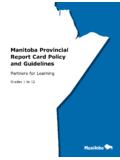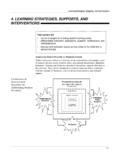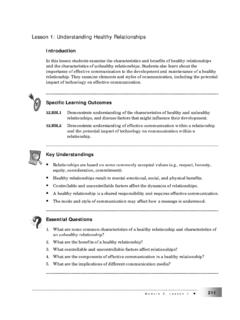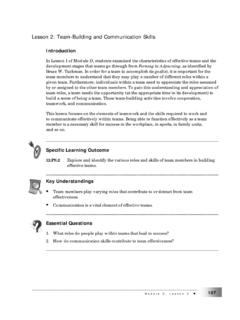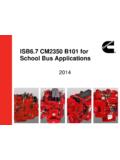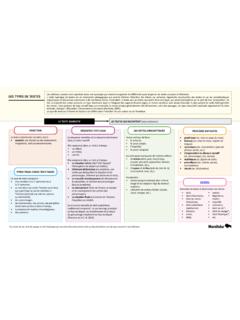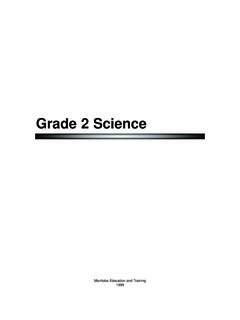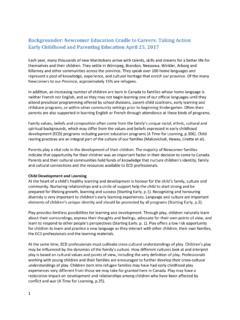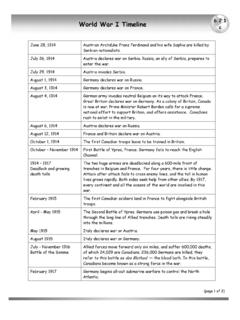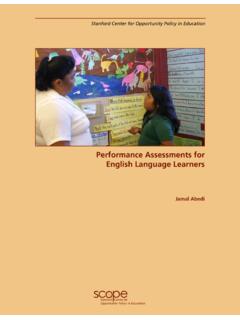Transcription of Middle Years Assessment Grade 8 English Language Arts ...
1 Middle Years Assessment Grade 8 English Language arts Reading Comprehension and Expository WritingSupport Document for TeachersMi d d l e Ye a r s as s e s sM e n t: Gr a d e 8 en G l i s h la nG u aG e ar t s: re a d i nG Co M p r e h e n s i o n a n d ex p o s i t o rY Wr i t i nGSupport Document for Teachers2017 Manitoba Education and TrainingManitoba Education and Training Cataloguing in Publication DataMiddle Years Assessment : Grade 8 English Language arts : reading comprehension and expository writing : support document for teachersIncludes bibliographical references. ISBN: 978- 0 -7711-7516 -9 (p df )1.
2 Reading comprehension Ability testing. 2. English Language Composition and exercises Ability testing. 3. Language arts (Secondary) Ability testing. 4. Middle school students Manitoba Evaluation. 5. Educational tests and measurements Manitoba. I. Manitoba. Manitoba Education and Training. 2017, the Government of Manitoba, represented by the Minister of Education and Training. Manitoba Education and Training School Programs Division Winnipeg, Manitoba, CanadaEvery effort has been made to acknowledge original sources and to comply with copyright law. If cases are identified where this has not been done, please notify Manitoba Education and Training.
3 Errors or omissions will be corrected in a future edition. Sincere thanks to the authors and publishers who allowed their original material to be used. Any websites referenced in this resource are subject to change without notice. Educators are advised to preview and evaluate websites and online resources before recommending them for student resource is available on the Manitoba Education and Training website at Disponible en fran the department is committed to making its publications as accessible as possible, some parts of this document are not fully accessible at this in alternate formats upon request.
4 ContentsiiiCo n t e n t sSection 1: Introduction 1 Middle Years Assessment Policy Overview 3 Section 2: Classroom-Based Assessment 5 Formative Assessment 7 Summative Assessment 8 Resources Supporting Classroom-Based Assessment 9 Section 3: Grade 8 English Language arts 11 Rationale for the Selection of Key Competencies in English Language arts 13 Provincial Reports on Student Performance 14 Exemplars of Student Work 25 Strategies to Support Reading Comprehension and Expository Writing in Grade 8 Classrooms 64 Suggestions for Selecting Reading Materials for Grade 8 Classrooms 67 Resources Supporting English Language arts 71 Resources Supporting Anglais and English Language arts Immersion 74 Section 4: Using Summative Assessment Data 77 Classroom 79 School and School Division 79 Province 79 Section 5: References 81se C t i o n 1.
5 In t r o d uC t i o nMiddle Years Assessment Policy Overview 3 Section 1: Introduction3in t r o d uC t i o nMiddle Years Assessment Policy OverviewManitoba Education and Training has developed a Middle Years Assessment Policy, published in Middle Years Assessment of Key Competencies in Mathematics, Reading Comprehension, Expository Writing, and Student Engagement (Manitoba Education and Advanced Learning, revised 2015). It applies to all students in Grade 7 and Grade 8 in provincially funded schools. The primary purpose of the policy is to enhance student learning and engagement through classroom-based Assessment processes that build student awareness and confidence in learning.
6 Research shows that both the quality and level of academic achievement and student engagement can be increased through formative Assessment ( Assessment for and as learning)*.The second purpose of the policy is to summarize data and report on the levels of achievement in key areas that Middle Years students have attained by the end of January. These key areas are based on what most Manitobans regard as vital for all students: a reasonable level of reading, writing, number skills, and student engagement. There are two distinct audiences for this summative Assessment ( Assessment of learning). One is the learning team, which comprises the teacher, student, and parents**.
7 Assessment information about each student reported in January can be used to plan the specific next steps in the student s learning and support the ongoing dialogue with parents. The second audience is the larger community the school, the school division, the department, and the public that can use the information to look for trends and make decisions about the provision of resources that further support and enhance student learning. * Assessment for learning refers to Assessment processes that assist the teacher in planning and differentiating instruction, that provide feedback on teaching and learning, and that enhance student motivation and commitment to learning.
8 Assessment as learning focuses on the student s thinking processes before, during, and after learning. Students reflect on their own learning and make adjustments in their thinking or behaviour to achieve deeper understanding. This self-regulation is critical in developing the independent, self-directed learning skills that students must acquire to thrive in the ever-changing world. For further information, see Rethinking Classroom Assessment with Purpose in Mind: Assessment for Learning, Assessment as Learning, Assessment of Learning (Manitoba Education, Citizenship and Youth, 2006).** In this document, the term parents refers to both parents and guardians, and is used with the recognition that in some cases only one parent may be involved in a child s C t i o n 2 : Cl a s s r o oM- Ba s e d as s e s sM e n tFormative Assessment 7 Summative Assessment 8 Resources Supporting Classroom-Based Assessment 9 Section 2: Classroom-Based Assessment7Cl a s s r o oM- Ba s e d as s e s sM e n tFormative AssessmentThe term formative Assessment is not new, but its definition is changing based on research on how Assessment enhances learning.
9 When the term first became part of the Language of educators in the 1960s, it referred to Assessment that took place mostly after learning activities were completed, leading to adjustments to the teaching and learning process to redress areas of weakness. With new research and increasing collaboration on Assessment initiatives among international educational bodies, the definition has expanded. We now view formative Assessment as information that is used to move learners forward and is gathered by the teacher and the student during, as well as after, the learning process. This external Assessment for learning, done by the teacher, fosters an internal Assessment as learning on the part of the student.
10 Research has found that the following strategies are most powerful when teachers use them to inform and adapt their instruction: clarifying and sharing learning intentions and criteria for success engineering effective classroom discussions, questions, and learning tasks providing feedback that moves learners forward activating students as the owners of their own learning activating students as instructional resources for one another (Leahy et al. 18)The active engagement of students is an essential element of Assessment that makes a positive difference in student learning. To become independent learners, students need to get an idea from the start of what is to be learned.
